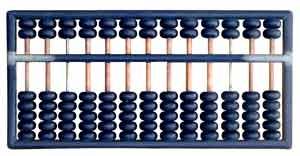Diagram of a typical Chinese abacus set to zero - all heaven beads pushed up and all earth bead pushed down.
Heaven beads, each worth 5

Earth beads, each worth 1
The Abacus utilizes a combination of two bases (base-2 and base-5) to represent decimal numbers. It is held horizontally with the smaller deck at the top. Each bead on the top deck has the value 5 and each bead on the lower deck has the value 1. The beads are pushed towards the central crossbar to show numbers. Working from right to left, the first vertical line represents units, the next tens, the next hundreds and so on.
So for example to show the number 9, on the first line, one heaven bead (top deck) would be moved down (representing 5 units) and 4 earth beads (bottom deck) would be moved up (each representing 4 units). To show the number 79, in addition to the beads in the first line used to make the number 9, one heaven bead would be moved down and two earth beads would be moved up on the second line, representing 5 tens and 2 tens respectively.
Addition on the abacus involves registering the numbers on the beads in the straight-forward left-to-right sequence they are written down in. As long as the digits are placed correctly, and the carry